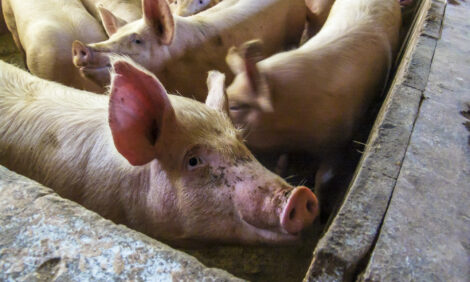



Concern Over Pig Strain of MRSA Exaggerated
DENMARK - A threat of MRSA from pigs affecting humans has been the centre of media concerns in Denmark. However, according to Pro Luca Guardabassi from the University of Copenhagen speaking at the Pig Industry Conference in Herning, there are other bacterial threats that hold far greater threats.And Prof Jaap Wagenaar from the University of Utrecht, in the Netherlands, where the strain of Methicillin Resistant Staphylococcus Aureus found in pigs was first identified agreed that other antibiotic strains of bacteria including E.coli could be more dangerous to the human population.
Prof Guardabassi said that the antibiotic methicillin was the most important antimicrobial to counter penicillin resistant Staphylococcus Aureus until the bacteria also became resistant to it.
The concerns in Denmark over the strain of MRSA found in pigs, particularly CC398 strain, saw a new hygiene protocol brought into practice on pig farms last year.
According to the Danish Pig Research Centre SEGES: “A high level of hygiene ensures that as little MRSA CC398 as possible is transmitted from livestock farms to the surrounding society. To limit the transmission of MRSA CC398 it is, therefore, crucial that everyone working on pig farms is aware of the responsibility in this regard.”
From 1 October last year, all Danish farmers with a health advisory agreement must implement a biosecurity protocol and must have an entry room where staff and visitors can wash their hands before leaving the premises.
These requirements are designed to decrease the risk of transmitting MRSA bacteria from livestock housing to the surrounding society.
MRSA is considered widespread among Danish pigs. The Pig Research Centre estimates that MRSA CC398 is found on more than 50 per cent of all Danish pig farms.
In the Netherlands, Germany, Spain and Italy, all pig farms are considered infected with MRSA.
MRSA CC398 may cause disease in humans, even though many are healthy carriers of the disease and MRSA CC398 may, just like other staphylococcus bacteria, cause infections, in particular skin infections with ulcer and abscesses.
In rare cases, infection may cause blood poisoning, and deaths have been recorded in Denmark, with four deaths up to August 2014 that can be associated with MRSA CC398. In the same period, 700 people have died from infections associated with other staphylococci.
However, MRSA CC398 is not restricted to pigs as it is also found in horses and strains of livestock associated LA-MRSA have also been found in veal calves in the Netherlands.
According to Prof Guardabassi, the concerns are that as the bacteria can be transferred to people, who are exposed to and in contact with pigs, it can also have an impact on health care if farmers enter hospitals.
“There is not only an impact on human health, there is also an economic impact,” Prof Guardabassi told the conference.
He added that the impact of the pig related strain of MRSA accounts for just 14 per cent of the total number of MRSA cases in Denmark with the number of deaths under one.
He said that the pig strain does not have a higher mortality rate than other strains.
“It is not more virulent than other MRSA clones and it is not more resistant to antibiotics,” he said.
He said that a screening method of control that has been adopted in both Denmark and the Netherlands is effective.
“The impact in Denmark is lower than in other European countries,” he said.
He said that Staphylococcus Aureus may not be the biggest problem and that E.coli could be worse.
“Staphylococcus Aureus is less common and less resistant to cephalosporins than E.coli,” said Prof Guardabassi.
“There is a lack of new antibiotics to tackle the problem of E.coli.”
He said that the problem with the pig strain of MRSA had been blown up by the Danish media and the press just focussed on this one type of bacteria.
“Denmark has a low prevalence of MRSA and it is important that we keep the incidents low, as Denmark is one of the main pig producing countries” said Prof Guardabassi.
“There was a similar strain in the Netherlands six years ago, but now we don’t talk about it.
“There was incomplete and inaccurate information in the media”
He said that the main danger from MRSA was to the elderly, when they have other problems as well and that all the infections had been found where pigs are bred.
“It is wrong to say that it is found in meat,” he said.
He added that researchers had also over-emphasised the importance of the research into the strain and people had been unnecessarily frightened.
He added that the Danish government had invested 35 million DKK (krone) to look into pig MRSA but the investment had been a political decision and not a decision made on risk.
“There are other bacteria far more dangerous,” he said.
Prof Wagenaar from Utrecht said that the Dutch policy of search and destroy had also included a restrictive use of antimicrobials and strict infection control when LA-MRSA was discovered in 2005.
He added that the Dutch control measures that were costing €8 million a year also included using bacteriophages on farm and management changes, with a strict reduction in the use of antibiotics.
The controls are also looking at reducing the shedding of the bacteria and the regulations call for gradual reduction of 20 per cent use and then 50 per cent use of antimicrobials.
“The reduction in use of antimicrobials by 65 per cent has helped to force down incidents,” he said.
“But it is not the biggest concern. Attention is now more towards E.coli,” Prof Wagenaar said.








